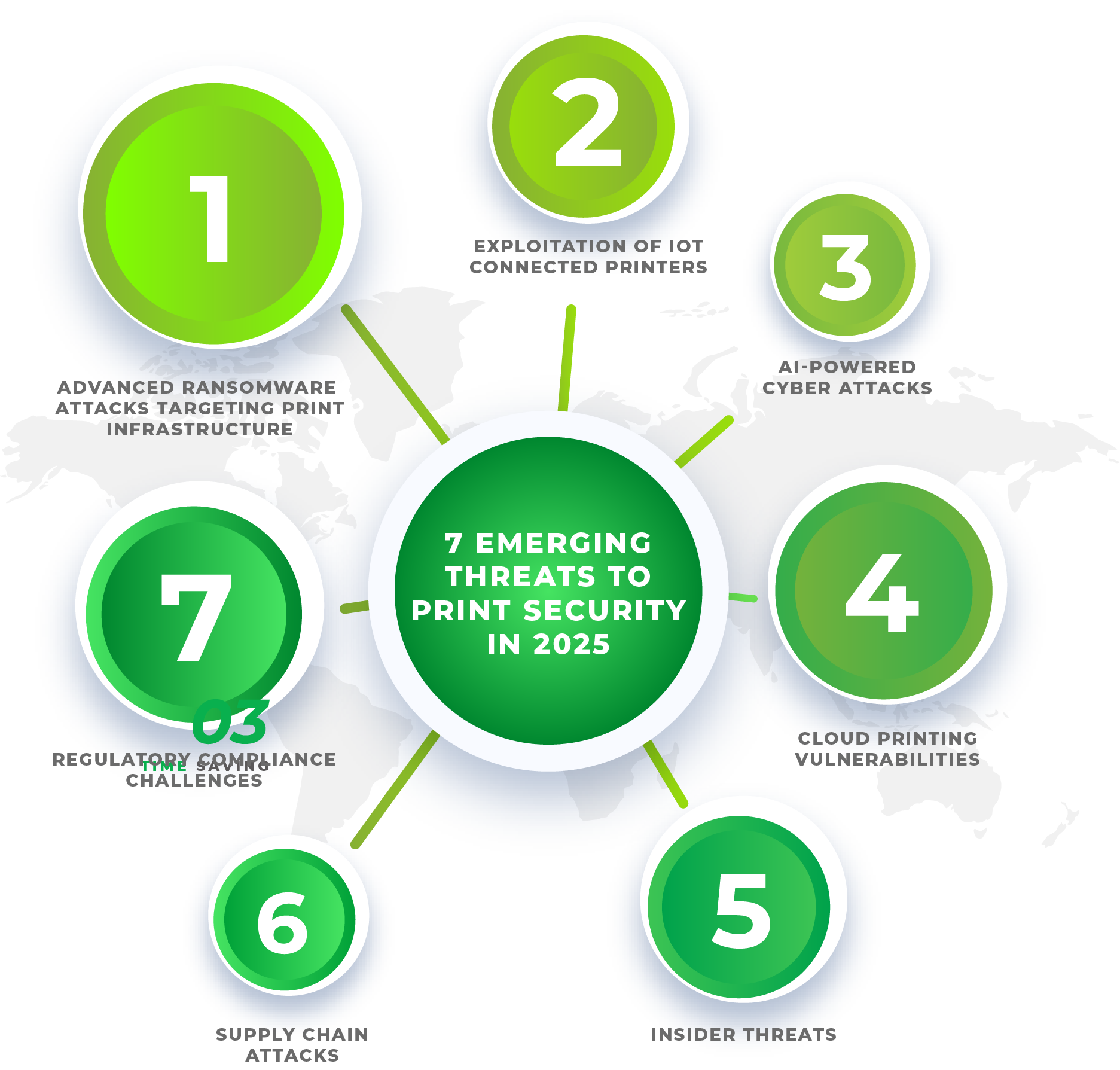7 Emerging Threats to Print Security in 2025

In 2025, as organizations continue to advance technologically, the security of print environments remains an overlooked aspect of cybersecurity.
Modern multifunction printers (MFPs) are mandatory to business operations connecting to complex networks.
This connectivity, while great for operations, also introduces new vulnerabilities. Understanding emerging threats to print security secures organizational data.
So, here are seven emerging threats to print security in 2025.
Advanced Ransomware Attacks Targeting Print Infrastructure
Ransomware attacks are changing. Cybercriminals are now developing complex methods to infiltrate networks. In 2025, print infrastructure has become a prime target.
Similarly, attackers can now deploy ransomware to encrypt data stored on networked printers. This disrupts operations so the attackers can demand ransoms for restoration.
Lastly, the interconnected nature of MFPs means that a compromised printer can serve as a gateway to the broader network, amplifying the potential damage.
Solution
Regular Firmware Updates: All of your printers should have the latest firmware to protect against known vulnerabilities.
Network Segmentation: Isolate print devices from central systems to prevent lateral movement within the network.
Create Backups: Maintain regular backups of print server configurations and data to facilitate recovery without yielding to ransom demands.

Exploitation of IoT-Connected Printers
The integration of printers into the Internet of Things (IoT) is bringing functionality but also expands the attack surface. Attackers can exploit the IoT-connected printers if you properly secure them.
Failure to secure them also gives unauthorized access to sensitive information. Other than that it serves as entry points for broader network attacks.
Solution
Strong Authentication Mechanisms: Implement multi-factor authentication (MFA) for accessing printer settings.
Regular Security Audits: Conduct periodic assessments to identify vulnerabilities in IoT-connected printers.
Disable Unnecessary Features: Turn off unused services to minimize potential entry points for attackers.

AI-Powered Cyber Attacks
Here’s another threat to print security in 2025.
Artificial Intelligence (AI) has become a double-edged sword in cybersecurity. While it aids in defense, attackers also leverage AI to conduct more sophisticated attacks.
In the context of print security, AI can be used to exploit vulnerabilities in print devices. This can include automating attacks or bypassing traditional security systems.
Solution
AI-Driven Defense Systems: Deploy AI-based security systems capable of responding to anomalous activities in real-time.
Continuous Monitoring: Implement systems that provide ongoing surveillance of print activities to mitigate threats promptly.
Employee Training: Educate staff about AI-driven phishing attempts that could compromise print security.
Cloud Printing Vulnerabilities
The shift towards cloud-based printing services offers flexibility, especially for remote workforces.
However, it also introduces risks related to data transmission. Without proper security protocols, sensitive documents sent to cloud print services can be accessed by unauthorized parties.
Solution
Data Encryption: All your data transmitted to and from cloud print services should have encryption through robust protocols.
Secure Access Controls: Implement strict access controls so that only authorized users can retrieve print jobs.
Regular Compliance Audits: Conduct audits so that the cloud print services comply with relevant data protection regulations.
Cloud-based compatibility is another valuable feature, enabling seamless integration with platforms like Google Drive, Dropbox, and Microsoft OneDrive.
MPS Company, part of the Gulf Commercial Group, is a leading provider of office technology solutions. This affiliation allows us to take a unique, specialized approach, benefiting from the group’s extensive expertise.
Insider Threats
Employees with access to print infrastructure can compromise print security. Insider threats are particularly challenging because they involve individuals who already have authorized access to systems.
Solution
Role-Based Access Control (RBAC): Limit access to print functions based on the user’s role within the organization.
Activity Monitoring: Implement monitoring to track print activities. This will identify unusual patterns that may indicate malicious intent.
Regular Training Programs: Educate employees about the importance of print security. Also tell them about the potential consequences of malicious actions.
Supply Chain Attacks
Attackers may target the supply chain of print devices. This compromises hardware or firmware before it reaches the end-user.
Such attacks can embed malicious code within printers. This can then infiltrate an organization’s network upon installation.
Solution
Procure from Trusted Vendors: Source print devices and components from reputable manufacturers with stringent security practices.
Inspect New Devices: Conduct thorough inspections of new printers before integrating them into the network.
Firmware Verification: Regularly verify the integrity of printer firmware. Also apply updates from trusted sources.
Regulatory Compliance Challenges
As data protection regulations become more stringent, the print environment should comply with laws such as GDPR, HIPAA, or CMMC which are quite complex. Similarly, non-compliance can result in significant fines.
Solution
Implement Audit Trails: Maintain detailed logs of all print activities to provide accountability.
Data Retention Policies: Enforce policies for the secure storage of printed materials containing sensitive information.
Regular Compliance Training: Keep staff informed about current regulations related to print security.
Conclusion
That’s a wrap for 7 Emerging Threats to Print Security in 2025.
As we progress through 2025, the technology of print security is fraught with threats. That’s why they now require proactive measures.
Organizations must recognize that printers are not mere peripheral devices but central components of the IT ecosystem that demand secure security measures.
By addressing these emerging threats through technological methods, businesses can fortify their defenses against potential breaches originating from print environments.
FAQs
In 2025, print security threats include AI-driven attacks, IoT vulnerabilities, and sophisticated ransomware targeting networked printers.
Attackers may use AI to exploit printer firmware vulnerabilities, enabling unauthorized access to sensitive data.
IoT-connected printers can serve as entry points for cyberattacks if not properly secured, potentially compromising entire networks.
Ransomware can infiltrate printers, disrupting operations and demanding payment to restore functionality.
Implementing zero-trust principles ensures strict authentication and continuous monitoring, reducing unauthorized printer access.
Yes, compromised components or firmware in the supply chain can introduce security risks to printers.
Regular security audits, firmware updates, and implementing robust access controls are essential measures.
